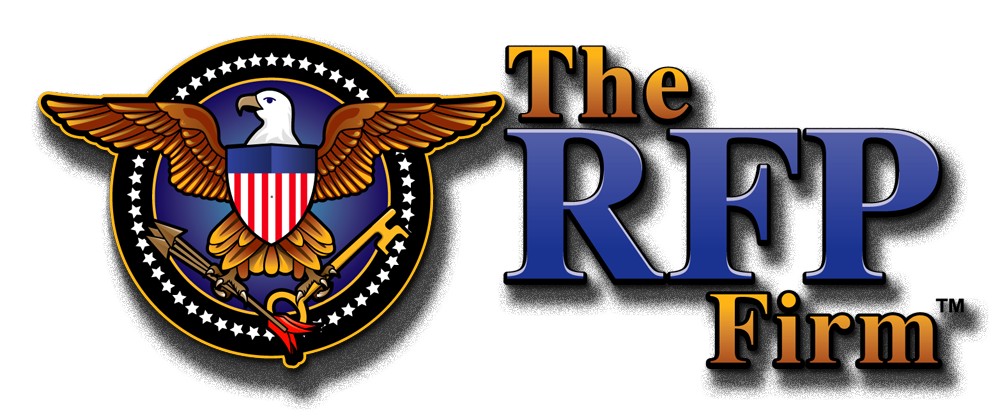Blog
Government & Commercial Proposal Writing Services
 The RFP Firm is expert at writing proposals in Response to Federal and State Government RFP Solicitations that will give you a Competitive Advantage over your competition.
The RFP Firm is expert at writing proposals in Response to Federal and State Government RFP Solicitations that will give you a Competitive Advantage over your competition.


Proposal Writing Services , RFP Proposal Consulting, Government RFP writing
Government RFP Proposal Writing Services
Government & Commercial Proposal Writing Services
 The RFP Firm is expert at writing proposals in Response to Federal and State Government RFP Solicitations that will give you a Competitive Advantage over your competition.
The RFP Firm is expert at writing proposals in Response to Federal and State Government RFP Solicitations that will give you a Competitive Advantage over your competition.

While incredibly important, the RFP process is often complex and time-consuming. It is a challenge for many, but with the right approach and resources, you can speed up the process. In this blog, we’ll offer you tools to enable you to feel more confident managing RFPs. We’ll start with understanding what they are, the roles in the RFP process and the key steps in the process.
The RFP (Request for Proposal) process can be complex and quite challenging and time-consuming, especially for small businesses where the key personnel are all 100% occupied running the business. The RFP Firm can help speed up the process. During the proposal development process there are several key steps. First let us review some of the key issues:
Understanding what is an RFP
Fundamentally, an RFP is a solicitation issued by a government agency looking to purchase a product or service from a private company/contractor/vendor. The RFP is a request from vendors to submit proposals that demonstrate their qualifications, experience, and cost for fulfilling the project’s scope of work according to a specific business proposal format defined in the instructions. The government agency then evaluates each proposal submitted and usually grades and scores each relevant component. Typically, the proposal that receives the highest overall score gets awarded the contract.
Resources necessary during the proposal development process
Often, for a small business the owner, president, or CEO or other officer has the most knowledge of the business and its past experience performing similar contracts and, therefore, is the most qualified to articulate and pull together the required information. They can coordinate accessing that information from other departments within their organization and discuss the best strategy for explaining how they do what they do and the best past contracts to use as examples to prove that the company has the experience similar in scope to the RFP requirements.
Proposal Writer/Consultant: The proposal consultant/writer has the responsibilities for reviewing all of the RFP documents and identifying all of the compliance requirements to ensure 100% compliance with the legalities to guarantee the proposal does not get thrown out on a technicality, outlining the content requirements for each and every section and subsections for each of the required proposal documents, and developing the proposal template used for capturing the content. This includes an appropriate cover page, transmittal letter, table of contents, and often a list of acronyms and compliance matrix when requested. Then incorporating and editing the required content, ensuring clear and concise copy, perfect grammar and punctuation, adding headers and sub-headers, formatting the content so that it is easy to read and looks good on the page, ensuring that statements are supported by proofs, and creating tables, charts, and callouts where necessary.
Prior to submitting content for any section to the proposal writer, the client team should review their content and sign-off internally, thereby not having to redo the effort again and again. As the content for each section is incorporated, a draft is returned to the client to review and ensure that nothing has been misstated and any missing information is identified and requested. Then, any additional content is incorporated.Prior to submitting content for any section to the proposal writer, the client team should review their content and sign-off internally, thereby not having to redo the effort again and again. As the content for each section is incorporated, a draft is returned to the client to review and ensure that nothing has been misstated and any missing information is identified and requested. Then, any additional content is incorporated.
The pricing portion of a proposal is always critical to ensure that you are in a competitive range. This is important as pricing that is too far outside of the median range of bidders, i.e., to high or too low, is often given a low score in the evaluation. Some RFPs are LPTA (Lowest Price Technically Acceptable) and will first rank the proposals based on price, review the lowest priced offer first, and if technically acceptable, not consider any of the others. In this case, you must provide your lowest possible pricing.The pricing portion of a proposal is always critical to ensure that you are in a competitive range. This is important as pricing that is too far outside of the median range of bidders, i.e., to high or too low, is often given a low score in the evaluation. Some RFPs are LPTA (Lowest Price Technically Acceptable) and will first rank the proposals based on price, review the lowest priced offer first, and if technically acceptable, not consider any of the others. In this case, you must provide your lowest possible pricing.
Of course, for all proposals, your pricing should be what they call “reasonable” with a modest profit. Always be sure that you will be satisfied with your pricing as there is no reason to bid on a project at too low a price where you will not be satisfied. Sometimes, you’ll need to provide a lot of details showing hourly rates, markups, overhead/G&A, profit, etc. At other times, they just ask for a flat fee.
Basic Steps in the Proposal Process
In order to achieve the goal of the government’s RFP, your proposal needs to provide all of the requested information in the required format with nothing left out or disregarded. One huge mistake businesses make is to just state that they will do the work, but not how they will do it, with what resources, who will do what, and what qualifications and experience your company and proposed team have to accomplish the required tasks. Provide proofs of what you say in order to earn the confidence of the evaluation team that you can successfully accomplish the tasks described in the scope of work.
And, wherever possible, it is critical to differentiate your business and technical approach from the competition so that you stand out from the other vendors with a unique approach or experience or technology.
The basic steps include:
It is crucial within the narrative to emphasize how you will help the agency to overcome any crucial issues or problems that they are seeking to solve or improve. In addition, identify any additional benefits that they will receive from you as the vendor that are provided at no additional cost. Often, these are methods, technologies, or other assets that are a normal part of your operations. Describe the positive experience they will have with your company as the vendor of choice and the benefits they will receive as a result.
The information requested in an RFP can vary widely, but typically includes:
Government agency’s evaluation process
During this process they will often create a short list of potential vendors and even request onsite presentations and/or demo where they can ask questions which also allows you to provide more detailed explanations.
It is always best to accept the government’s contract terms without exception early in your proposal as this can often disqualify you from being awarded a contract.